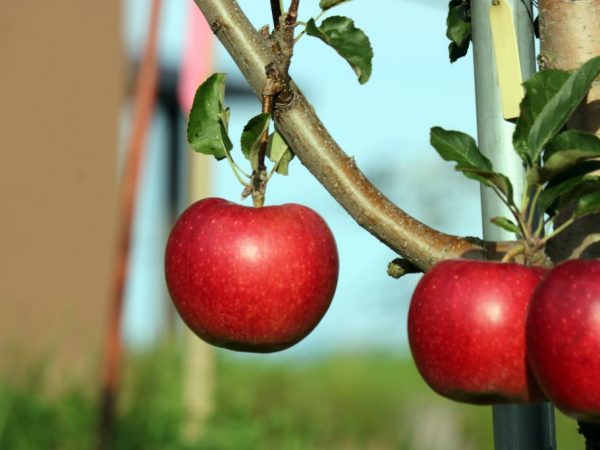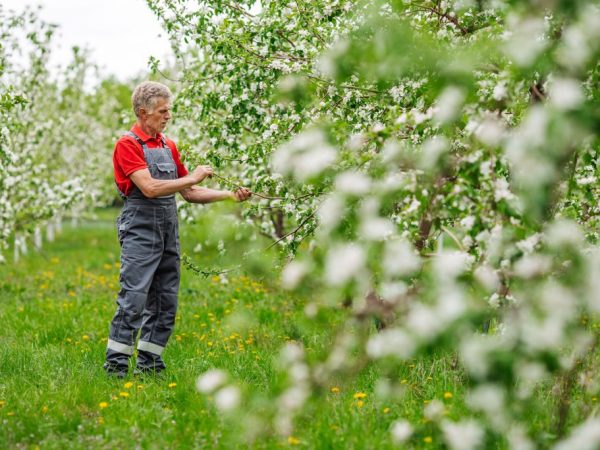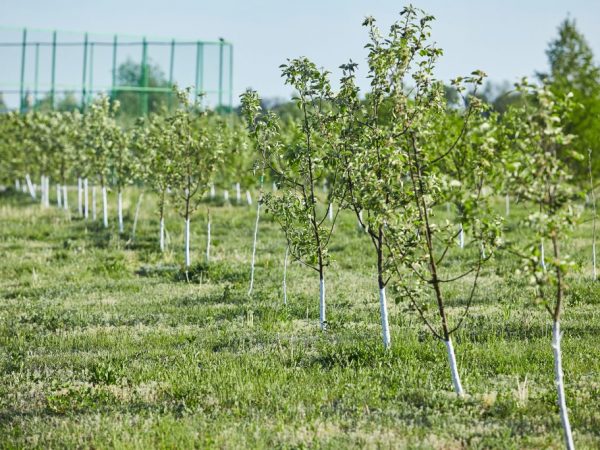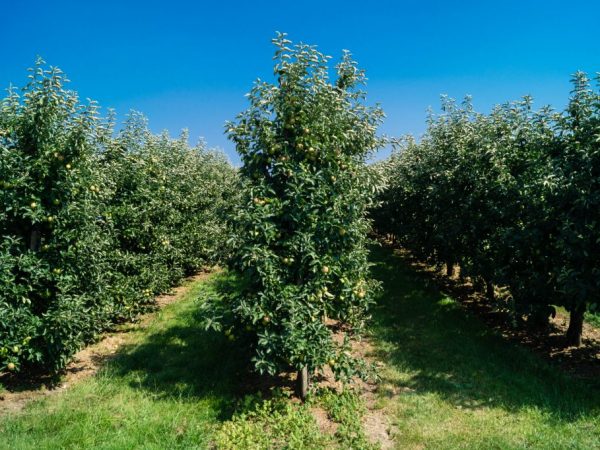Description of Starkrimson apple tree
The Starkrimson apple tree instantly spread throughout Europe. Having got into the territory of the Soviet Union in the 30s and 40s, it began to be actively cultivated for industrial purposes in the Caucasus.
- Description of the variety
- Taste characteristic
- Fertility and pollinators
- Yield
- Annual growth
- Winter hardiness of the variety
- Disease resistance
- Planting seedlings
- Site selection and preparation
- Timing
- Landing technology
- Apple tree care
- Watering and feeding
- Pruning seedlings
- Prevention and protection against pests
- Shelter for the winter
- Features of ripening and fruiting
- Collection and storage
- Types of apple trees
- Growing in regions
- Advantages and disadvantages of the variety

Description of Starkrimson apple tree
Description of the variety
Apple variety Starkrimson has a beautiful appearance.
The apples are large. One weighs 175-200 g. Fruits of an amazing color - they are bright, juicy, crimson-crimson - this makes them so appetizing and attractive. Covered with a rough, dense skin. Thanks to bloom, they are perfectly stored for a long time.
The tree takes up little space in the garden, since the seedlings reach a height of 4.5-5 m. The crown is compact and in an adult tree resembles an inverted pyramid in shape.
The branches do not grow densely, so the seedlings do not need to be thinned annually.
The bark is brown with a grayish bloom. The seedlings are completely covered with fruit branches - ringlets. In spring, numerous ovaries form on them. The foliage is large, emerald green. It has sharp jagged edges and looks like an egg.
The tree blooms with pinkish-white buds, which begin to form abundantly with the arrival of warm days.
Taste characteristic
Experts rate the Starkrimson apple at 4.5 points (out of 5 possible).
The taste is pleasant - moderately juicy and sweet. The longer the plucked fruits are stored, the more vividly their taste and aroma are manifested.
They contain useful acids, sugars, vitamins and minerals.
100 g of pulp contains 5-7 mg of vitamin C, so the fruit is useful for strengthening the immune system.
Fertility and pollinators
The apple tree is not capable of self-pollination. In order for the seedlings to give a bountiful harvest, pollinating plants are grown next to them on the same garden plot.
For these purposes, the following varieties are used: Jonagold Deposta, Jonathan and Golden Delicious.
The optimal distance at which other fruit trees are planted: 1.5-2 m.
Yield
With proper care, you can get a good harvest every year. The main thing is not to forget about regular watering, protect the seedlings from small rodents and monitor the temperature regime, subzero temperatures can be detrimental to the fruit.
The apple tree will bring its first harvest 2-2.5 years after planting. By properly planting seedlings and providing them with proper care, 150-160 kg of fragrant and juicy fruits can be harvested from one tree.
Annual growth

New shoots are formed in spring
Fresh shoots are formed with the arrival of spring. Every year the apple tree is renewed with young shoots. Like any other spurous plant, the new branches have a sharp tip that looks like a thorn.
Winter hardiness of the variety
Saplings do not like freezing temperatures.A severe cold snap can lead to complete freezing of the garden.
According to the description, the Starkrimson variety is grown in warm regions: the apple tree will thrive in a southern climate with mild winters.
In our country, this is the Stavropol and Krasnodar Territories, the Rostov Region. To prevent the seedlings from freezing with the arrival of cold weather, measures are taken to thoroughly insulate them.
Disease resistance
The variety tolerates well many diseases that affect fruit trees. He is not afraid of fungal infections that cause powdery mildew and gray rot. Culture needs constant monitoring. The first signs of any disease will immediately affect the appearance of the plant and fruits.
The most dangerous are: moth, mice and moles.
Planting seedlings
In order to grow a beautiful garden that will yield a bountiful harvest, it is important to choose the right seedlings for planting.
There are a number of guidelines to help you avoid the most common mistakes.
- For breeding fruit trees, choose young shoots that are no more than 1-1.5 years old.
- Examine the seedlings carefully. They must be safe and sound.
- Examine the shoots for diseases - there should be no seals on the bark of the trunk.
- Keep the roots of the apple tree moist.
- Pay attention to the choice of a place in the garden.
Site selection and preparation
This variety needs abundant lighting, therefore, when placing seedlings in the garden, give preference to sunny areas. Make sure that the area is protected from the through wind. The most suitable soil is loam. The soil in which water stagnates is completely unsuitable for planting.
The Starkrimson apple tree can be planted in both autumn and spring.
Timing
Many gardeners prefer to plant trees with the arrival of heat, when the threat of temperature extremes disappears. Over the summer, the shoots will have time to take root and by the arrival of winter, they will calmly accept climatic changes.
In the spring

Young trees need good lighting
The soil is prepared in advance.
- Dig up the ground so that it is enriched with oxygen and remove the weeds thoroughly.
- Trees are planted before buds can form on them.
- Prepare the seat in advance. Don't forget drainage. Use expanded clay for this.
- The soil should be fertilized. Usually top dressing consists of humus (1-2 kg) and nitroammofoska (20-25 g). The mixture is gently mixed and added directly to the ground.
Watch out for the root collar, do not over-immerse it in the soil. After placing and digging in the seedlings, they should be watered abundantly. To make the trees grow even, make supports for them from wooden pegs. From above, the soil is covered with mulch.
In autumn
Prepare the seat carefully. The soil must be dug deep enough - 80-90 cm.
For fertilization, use organic matter: humus or manure (at the rate of 5-6 kg per 1 sq. M) and ash (500 g). These substances contain all the necessary trace elements for the seedlings not only to take root well, but also to actively grow.
Do not forget to mix the soil well after adding fertilizers.
Landing technology
Landing is carried out as follows:
- dig holes 75-85 cm deep;
- add fertilizers (it can be sand, rotted leaves, ash, manure);
- water the soil abundantly: you will need 15-20 liters of water for one seedling;
- place a tree in the hole, make sure that its roots are straightened;
- backfill the earth and compact the soil around the apple tree.
If you have never grown fruit trees following the advice, you will be able to do it in your garden without any problems.
Apple tree care
You will only be able to grow a good harvest if you constantly look after the sprouts.
We'll have to closely monitor the seedlings.In order for the tree to grow strong and healthy, do not forget about regular watering and applying mineral fertilizers, and loosening the soil.
Watering and feeding
Constant watering is the basis for the active growth of Starkrimson seedlings. This variety does not tolerate drought, so during the summer, trees should be watered every 6 days in normal weather.
During a steady heat, the sprouts need more water. Water more often - every 2-3 days.
Mulch will help to retain and retain moisture in the soil. To do this, use bark, spruce needles or sawdust. Covering the soil will not only reduce evaporation, but also protect the seedlings from small rodents.

The variety needs regular watering
Mineral fertilizers are applied 3-4 times per season. When choosing a top dressing, be guided by the weather outside the window. With the arrival of spring, it is important not to forget about nitrogen fertilizers.
In cold weather, pay attention to potash and phosphorus substances. Fertilizers can be purchased at specialized stores. On the packaging, carefully study how to use this or that drug.
Pruning seedlings
The apple tree has a neat and not very thick crown. The main shoots rarely grow, so they do not need thinning. Just make sure that dried shoots do not interfere with the development of new ones.
Cut off dead and diseased branches every 2 years.
Prevention and protection against pests
The biggest threat to Starkrimson apples is a fungal disease called scab.
The disease manifests itself in the form of a gray coating and rusty spots on the inside of the foliage. As the infection progresses, it kills. The crown turns black and flies around. Gradually, the fungus gets over to the fruits, as a result of which they shrink and fall off.
As soon as you notice the first signs of the disease, immediately start treating the seedlings.
To preserve the harvest, carefully remove all infected leaves and fruits (they should be burned) and treat the trees with a solution of Bordeaux liquid.
Fungal spores can persist in the soil for a long time: so that they are not transferred to other plants, the soil should be sprayed with a 10% ammonia solution. Treatment can be carried out no later than a month before harvest.
In the winter season, various rodents can pose a threat to plants: to protect the seedlings, they need to be covered.
Shelter for the winter
Caring for plants continues in the cold season. Since this variety does not tolerate sub-zero temperatures, young seedlings need shelter. The wind and winter sun can cause irreparable damage to trees, leading to poor harvests - the fruits will be small, sour and diseased.
Agrofibre, roofing felt and cellophane are used as insulation for the bark.
To protect the roots from freezing, coniferous branches are laid around the plants. In young shoots, not only the lower part should be covered, but also the crown.
Features of ripening and fruiting
It will take several years before your seedlings begin to bear their first fruits. At first, there won't be very many apples. Get ready to harvest a bountiful harvest in 5 years.
The flowering of seedlings begins in late spring. The maturation of plants depends on the weather. If the heat reigned in summer, the fruits will begin to ripen much earlier - at the beginning of September. Cold weather will delay this process by several weeks.
To understand that it's time to harvest, a few rules will help:
- the fruits have grown large enough;
- they are easily removed from the branch;
- in the section of the apple, you can see the ripe seeds of a dark brown color.
Collection and storage

Fruits are stored for a long time
Apples are harvested in September-October. It is not worth delaying this process, otherwise they may lose their taste.
The storage period is long. The fruits have good keeping quality. In the cellar, fruits are perfectly preserved until next spring. If you keep the fruits in a warm room, they will very quickly lose their presentation.
Do not water the trees before harvesting. The best time for this is noon (the fruits will have time to dry out from the dew).
They pick apples, starting from the lower branches and gradually moving towards the top. There is no need to jerk the fruits. Try to roll them around the stalk. Be careful not to damage the skin and keep the apples intact.
It is forbidden to shake the seedlings. Use the stepladder to get to the top of the head. Fallen, dented and spoiled fruits are not suitable for long-term storage. They should be eaten or processed first.
Types of apple trees
The description indicates that there are 2 types of seedlings.
- Starkrimson dwarf apple trees are small in stature, they do not grow more than 3-3.5 m, which greatly facilitates harvesting.
- Columnar seedlings are apple trees that, as a result of natural cloning, lack side shoots. The fruits form and ripen on the central trunk. The tree is literally sprinkled with juicy apples.
Growing in regions
Due to its low frost resistance, this variety is not suitable for growing on an industrial scale in the Volga region or the Moscow region. Breeders do not stop experimenting, but all attempts to collect a bountiful harvest in these areas have been unsuccessful.
Similar problems are faced in neighboring countries: in Ukraine, high yields are achieved in regions with a warm and temperate climate.
Advantages and disadvantages of the variety
The Starkrimson apple tree is a unique variety that has many advantages that gardeners have appreciated.
- early maturity and abundant productivity;
- beautiful shape and color of the fruit;
- attractive presentation of apples;
- resistance to the fungal disease powdery mildew;
- application, both in natural form and as a base for jams, preserves, compotes.
The disadvantages include the following points:
- poor tolerance to low temperatures;
- needs regular watering and does not like drought;
- apples do not differ in standard size - both large and small ones can be found on the same tree;
- branches break easily under the weight of the fruit;
- seedlings often suffer from rodent and pest infestations.

